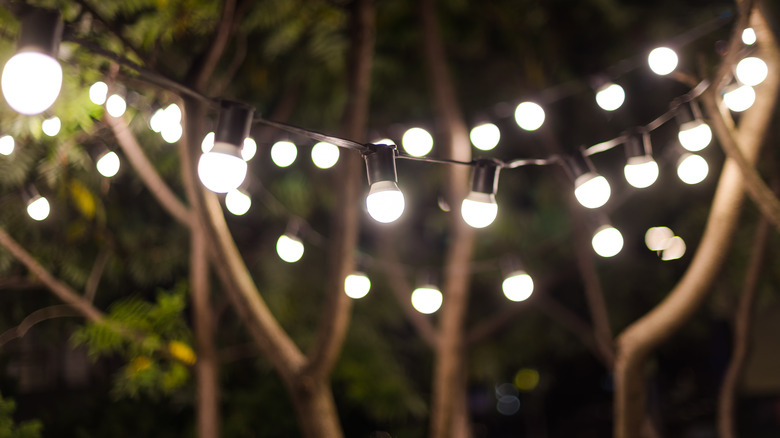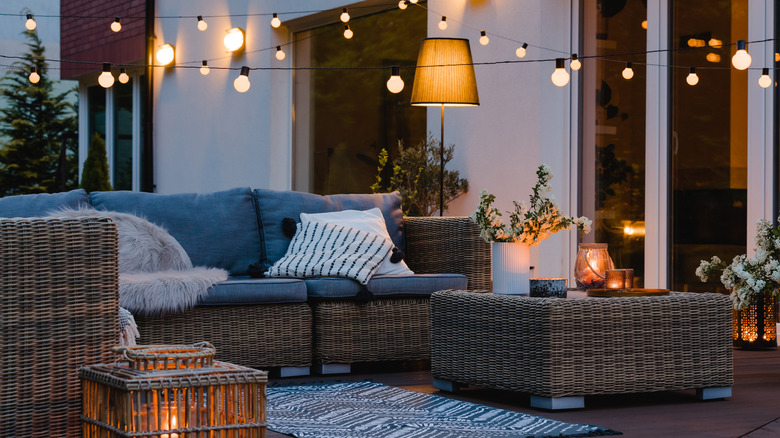Jessica Alba Explains The Best Way To Hang String Lights For An 'Adult' Patio Space
Once you have the basics of your patio space in place, such as seating options and other furniture, the next step is to add decorative embellishments such as lighting. These touches truly level up a space. Many people opt for one of the most popular decorative features: string lights that illuminate an outdoor area and create a cozy ambiance.
However, as actress and entrepreneur Jessica Alba discovered, string lights can run a range from looking cheap and juvenile to chic and sophisticated, depending on what type of lights you choose and how they're hung. While stringing lights around the perimeter of your outdoor area may seem like the simplest solution, it can skew a little more "college," Alba says in an Honest Makeover Amazon Edition video. Instead, try hanging outdoor string lights in a zig-zag style that provides an illuminated ceiling of sorts over your space for a more grown-up configuration.
For a polished look, there are a few other factors to consider, including proper measurements. For example, if the distance back and forth across the area you're looking to cover is 50 feet, you might assume that a 50-foot string of lights would be perfect. However, most string lights have a slight arc in order to give them a more natural look. Consequently, you'll always want to add a few extra feet to ensure you don't run short, leaving the end of the cord dangling somewhere for a decidedly unpolished final product.
Hanging patterns to consider
While working with an interior designer to transform her own patio space, Alba learned about the zig-zag hanging pattern. "If you zig-zag them on a pergola, or what have you, it looks more adult," she says in the video. "Who knew? There's a tip." However, this presents one major limitation that may prove challenging, depending on the configuration of the area you seek to illuminate.
A zig-zag approach requires several hanging points where the lights can be affixed before stretching across the area. If you're hanging lights across a pergola or own a deck with high-privacy screens, it shouldn't be an issue. However, if you're covering an open-area deck or a larger swath of outdoor space, you might find it tough to locate enough hanging points to make this pattern work.
Don't just default to stringing lights along the perimeter, though. There are other options. For a smaller space with limited hanging points, consider arranging the lights in a "V" or "X" shape. Both share many features with the zig-zag "W" pattern.
Alternatively, you might like a style called the "horizon point," where several light strands are affixed to one structure at one end and along the side of a wider structure at the other. This pattern provides an ideal solution for an open-air space where the strands could be attached to the side of the house on one side and along a pole in the yard on the other to cover the necessary area.
Hanging your lights safely and securely
Though aesthetic considerations are important when crafting your ideal outdoor space, you also want to ensure your patio lights are hung safely and securely.
First, while you could certainly string your lights as is, for added stability (and a chic, streamlined look), you set up a wire or fishing line as a base that you can then attach your patio lights to via zip ties. Then, consider the type of lights to use. If you're planning to go with patio lights that stay up year-round — and particularly if they're in a windy location or covering relatively long distances — select industrial LED string lights. They tend to be a bit pricier, but they're also far more durable. If, on the other hand, you intend on hanging lights somewhere more protected, such as underneath a covered patio, you might be able to opt for a more budget-friendly option. These types of lights aren't as well-suited to being up all year but can be a great decorative touch to pull out during the warmer seasons.
Finally, you'll want to calculate the voltage of your lights and ensure they work with whatever electrical source you have available, so as to not blow any fuses. Luckily, there are a lot of great low-voltage LED options nowadays that don't give off heat, making them an ideal solution if your lights are within reach and might potentially be touched by guests navigating the patio.


